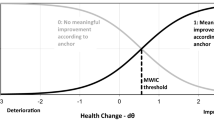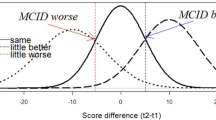Abstract
To assess significant changes of health status in people receiving health care, distribution-based and anchor-based methods have been proposed. However, there is no real consensus on what method is the best for evaluating clinically meaningful change. To maximize the internal and external validity of outcome assessment, we propose combining two approaches as recommended by recent practical guidelines on this field. Specifically, we suggest applying longitudinal hierarchical linear models on subgroups of patients showing reliable change and reliable and clinically significant change. This combined approach improved the model’s ability (1) to quantify the magnitude of changes to be reliable and clinically meaningful and (2) to select significant predictors of changes. An empirical application on a prevalence sample of Italian outpatients attending four community mental health services was done. A cross-sectional model and three longitudinal models were applied on the entire study sample and reliable and clinically meaningful change subsamples to investigate the magnitude of change and the predictive effect on outcomes of clinical, socio-demographic and process variables on different patients’ subgroups. Differences were found suggesting that both the statistical method and the sample used to calculate individual changes affect the estimates. The main conclusion is that ignoring the longitudinal data structure or including patients with unreliable change at the follow-up might result in misleading inferences that can alter the real magnitude of changes and the contributions of predictors. The approach proposed provides robust feedback to clinicians on clinically significant change and can be recommended in outcome studies and research.

Similar content being viewed by others
References
Bauer, S., Lambert, M.J., Nielsen, S.L.: Clinical significance methods: a comparison of statistical techniques. J. Pers. Assess. 82, 60–70 (2003)
Cella, D., Bullinger, M., Scott, C., Barofsky, I.: The Clinical Significance Consensus Meeting Group: group vs individual approaches to understanding the clinical significance of differences or changes in quality of life. Mayo Clin. Proc. 77, 384–392 (2002)
Christensen, L., Mendoza, J.L.: A method of assessing change in a single subject: an alteration of the RC index. Behav. Res. Ther. 17, 305–308 (1986)
Clarke, P.S.: Causal analysis of individual change using the difference score. Epidemiology 15, 414–421 (2004)
Cohen, J.: Statistical Power Analysis for the Behavioural Sciences. Academic Press, London (1969)
Commonwealth Department of Health and Ageing: National Outcome and Casemix Collection: Overview of Clinical Measures and Data Items. Commonwealth Department of Health and Ageing, Canberra (2002)
Crosby, R.D., Kolotkin, R.L., Williams, G.R.: Defining clinically meaningful change in health-related quality of life. J. Clin. Epidemiol. 56, 395–407 (2003)
Department of Health: Mental Health Information Strategy. Department of Health, London (2001)
Diggle, P.J., Heagerty, P., Liang, K.Y., Zeger, S.L.: Analysis of Longitudinal Data. Oxford University Press, Oxford (2002)
Eisen, S.V., Ranganathan, G., Seal, P., Spiro, A.: Measuring clinically meaningful change following mental health treatment. J. Behav. Health Serv. Res. 34, 272–389 (2007)
Evans, C., Margison, F., Barkham, M.: The contribution of reliable and clinically significant change methods to evidence-based mental health. Evid. Based Ment. Health 1, 70–72 (1998)
Food and Drug Administration: Guidance for industry on patient-reported outcome measures: use in medical product development to support labeling claims. Fed. Regist. 74(235), 65132–65133 (2009)
Goldstein, H.: Multilevel Statistical Models. Edward Arnold, London (1995)
Grundy, C.T., Lambert, M.J., Grundy, E.M.: Assessing clinical significance: application to the Hamilton Rating Scale for depression. J. Ment. Health 5, 25–33 (1996)
Hafkenscheid, A.: Psychometric measures of individual change: an empirical comparison with the Brief Psychiatric Rating Scale (BPRS). Acta Psychiatr. Scand. 101, 235–242 (2000)
Hageman, W.J., Arrindell, W.A.: Establishing clinically significant change: increment of precision between individual and group level of analysis. Behav. Res. Ther. 37, 1169–1193 (1999)
Jacobson, N.S., Truax, P.: Clinical significance: a statistical approach to defining meaningful change in psychotherapy research. J. Consult. Clin. Psychol. 59, 12–19 (1991)
Jacobson, N.S., Follette, W.C., Revenstorf, D., Baucom, D.H., Hahlweg, K., Margolin, G.: Variability in outcome and clinical significance of behavioral marital therapy: a reanalysis of outcome data. J. Consult. Clin. Psychol. 52, 497–504 (1984)
Kazis, L.E., Anderson, J.J., Meenan, R.F.: Effect sizes for interpreting changes in health status. Med. Care 27, 178–189 (1989)
Liang, M.H., Larson, M.G., Cullen, K.E., Schwartz, J.A.: Comparative measurement efficiency and sensitivity of five health status instruments for arthritis research. Arthritis Rheum. 28, 542–547 (1985)
Lovaglio, P.G., Monzani, E.: Evaluation of the Health of the Nation Outcome Scales in a community setting population. Qual. Life Res. 21, 1643–1653 (2012)
Lydick, E., Epstein, R.S.: Interpretation of quality of life changes. Qual. Life Res. 2, 221–226 (1993)
Matthey, S.: Calculating clinically significant change in postnatal depression studies using the Edinburgh Postnatal Depression Scale. J. Affect. Disord. 78, 269–272 (2004)
McGlinchey, J.B., Atkins, D.C., Jacobson, N.S.: Clinical significance methods: which one to use and how useful are they? Behav. Ther. 33, 529–550 (2002)
Monzani, E., Erlicher, A., Lora, A., Lovaglio, P., Vittadini, G.: Does community care work? A model to evaluate the effectiveness of mental health services. Int. J. Ment. Health Syst. 2, 10 (2008)
Nich, C., Carroll, K.: Now you see it, now you don’t: a comparison of traditional versus random effects regression models in the analysis of longitudinal follow-up data from a clinical trial. J. Consult. Clin. Psychol. 65, 252–261 (1997)
Norman, G.R., Sridhar, F.G., Guyatt, G.H.: Relation of distribution- and anchor-based approaches in interpretation of changes in health-related quality of life. Med. Care 39, 1039–1047 (2001)
Parabiaghi, A., Rapisarda, F., D’Avanzo, B., Erlicher, A., Lora, A., Barbato, A.: Measuring clinical change in routine mental health care: differences between first time and longer term service users. Aust. N.Z. J. Psychiatry 45, 558–568 (2011)
Pirkis, J.E., Burgess, P.M., Kirk, P.K., Dodson, S., Coombs, T.J., Williamson, M.K.: A review of the psychometric properties of the Health of the Nation Outcome Scales (HoNOS) family of measures. Health Qual. Life Outcomes 3, 76 (2005)
Raudenbush, S.W., Chan, W.S.: Application of a hierarchical linear model to the study of adolescent deviance in an overlapping cohort design. J. Consult. Clin. Psychol. 61, 941–951 (1993)
Rogosa, D.R., Willett, J.B.: Demonstrating the reliability of the difference score in the measurement of change. J. Educ. Meas. 20, 335–353 (1983)
Rogosa, D.R., Willett, J.B.: Understanding correlates of change by modelling individual differences in growth. Psychometrika 50, 203–228 (1985)
Rogosa, D., Brandt, D., Zimowski, M.: A growth curve approach to the measurement of change. Psychol. Bull. 92, 726–748 (1982)
Rossi, A., Amaddeo, F., Bisoffi, G., Ruggeri, M., Thornicroft, G., Tansella, M.: Dropping out of care: inappropriate terminations of contact with community-based psychiatric services. Br. J. Psychiatry 181, 331–338 (2002)
Sherman, M., Le Cessie, S.: A comparison between bootstrap methods and generalized estimating equations for correlated outcomes in generalized linear models. Commun. Stat. 26, 901–925 (1997)
Speer, D.C.: Clinically significant change: Jacobson & Truax (1991) revisited. J. Consult. Clin. Psychol. 60, 402–408 (1992)
Speer, D.C.: What is the role of two-wave designs in clinical research? Comment on Hageman and Arrindell. Behav. Res. Ther. 37, 1203–1210 (1999)
Speer, D.C., Greenbaum, P.E.: Five methods for computing significant individual client change and improvement rates: support for an individual growth curve approach. J. Consult. Clin. Psychol. 63, 1044–1048 (1995)
Stefanski, L.A., Cook, J.R.: Simulation-extrapolation: the measurement error jackknife. J. Am. Stat. Assoc. 90, 1247–1256 (1995)
Trauer, T.: Assessment of change in outcome measurement. In: Trauer, T. (ed.) Outcome Measurement in Mental Health, pp. 206–218. Cambridge University Press, Cambridge (2010)
White, H.: Maximum likelihood estimation of misspecified models. Econometrica 50, 1–25 (1982)
Willet, J.B.: Questions and answers in the measurement of change. In: Rothkopf, E. (ed.) Review of Research in Education (1988–89), pp. 345–422. American Education Research Association, Washington, DC (1988)
Wing, J.K., Beevor, A.S., Curtis, R.H., Park, S.B., Hadden, S., Burns, A.: Health of the Nation Outcome Scales (HoNOS). Research and development. Br. J. Psychiatry 172, 11–18 (1998)
Wyrwich, K., Nienaber, N., Tierney, W., et al.: Further evidence supporting an SEM-based criterion for identifying meaningful intra-individual changes in health-related quality of life. J. Clin. Epidemiol. 52, 861–873 (1999)
Author information
Authors and Affiliations
Corresponding author
Rights and permissions
About this article
Cite this article
Lovaglio, P.G., Parabiaghi, A. Assessment of meaningful change in routine outcome measurement (ROM) with a combination of a longitudinal and a ‘classify and count’ approach. Qual Quant 48, 2479–2499 (2014). https://doi.org/10.1007/s11135-013-9902-9
Published:
Issue Date:
DOI: https://doi.org/10.1007/s11135-013-9902-9




